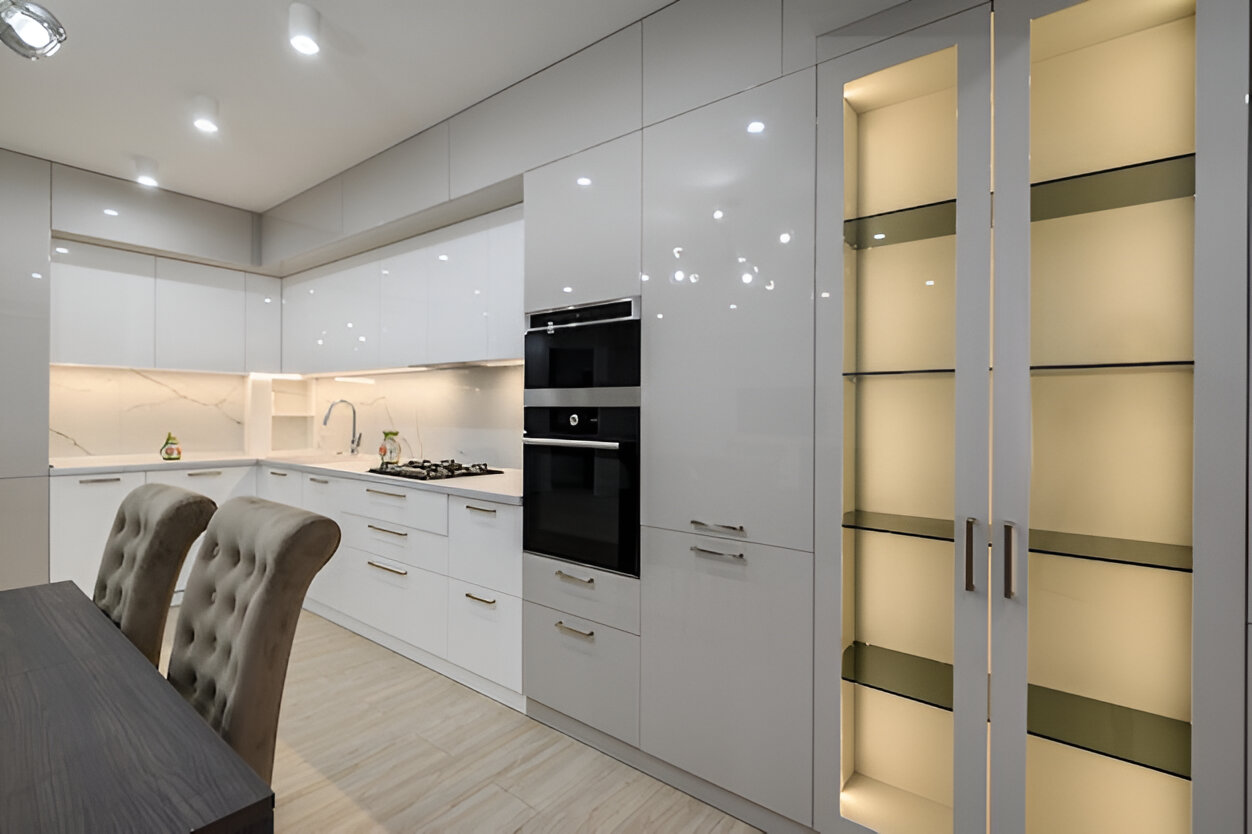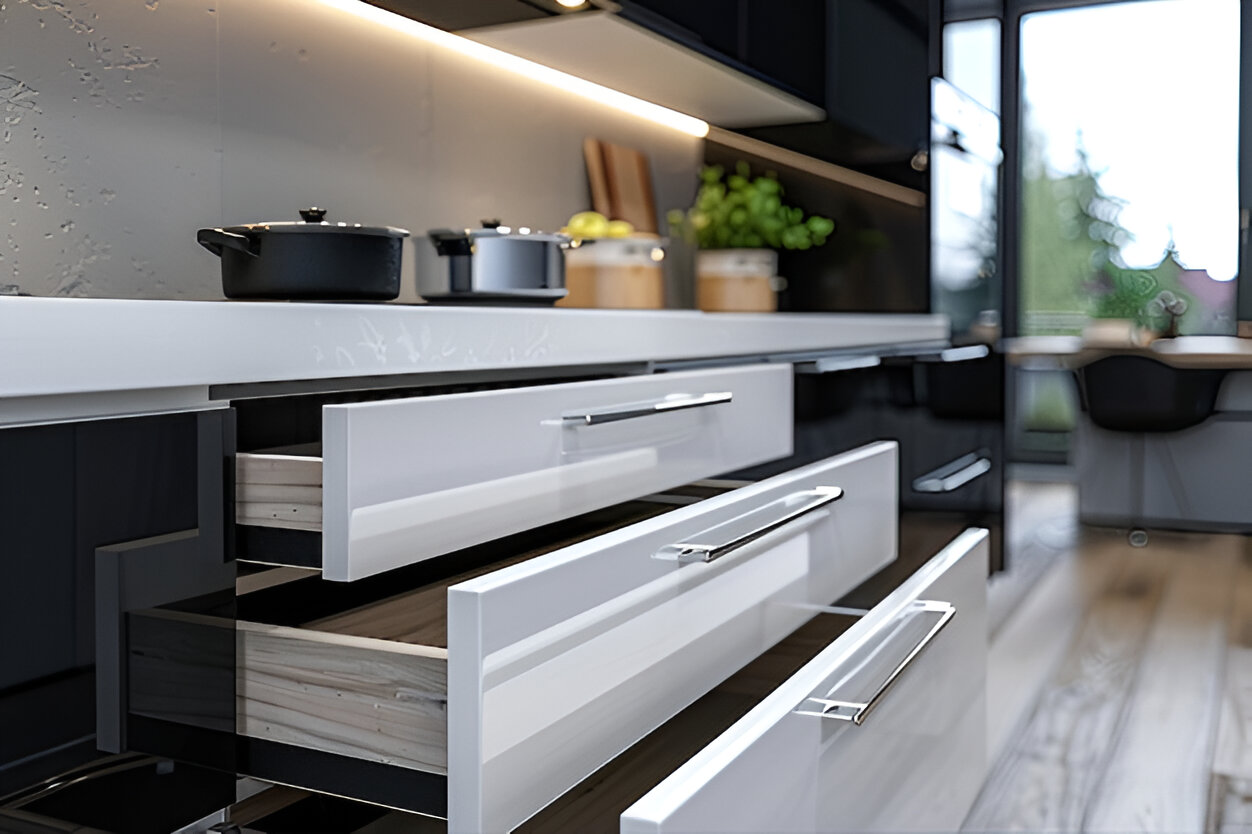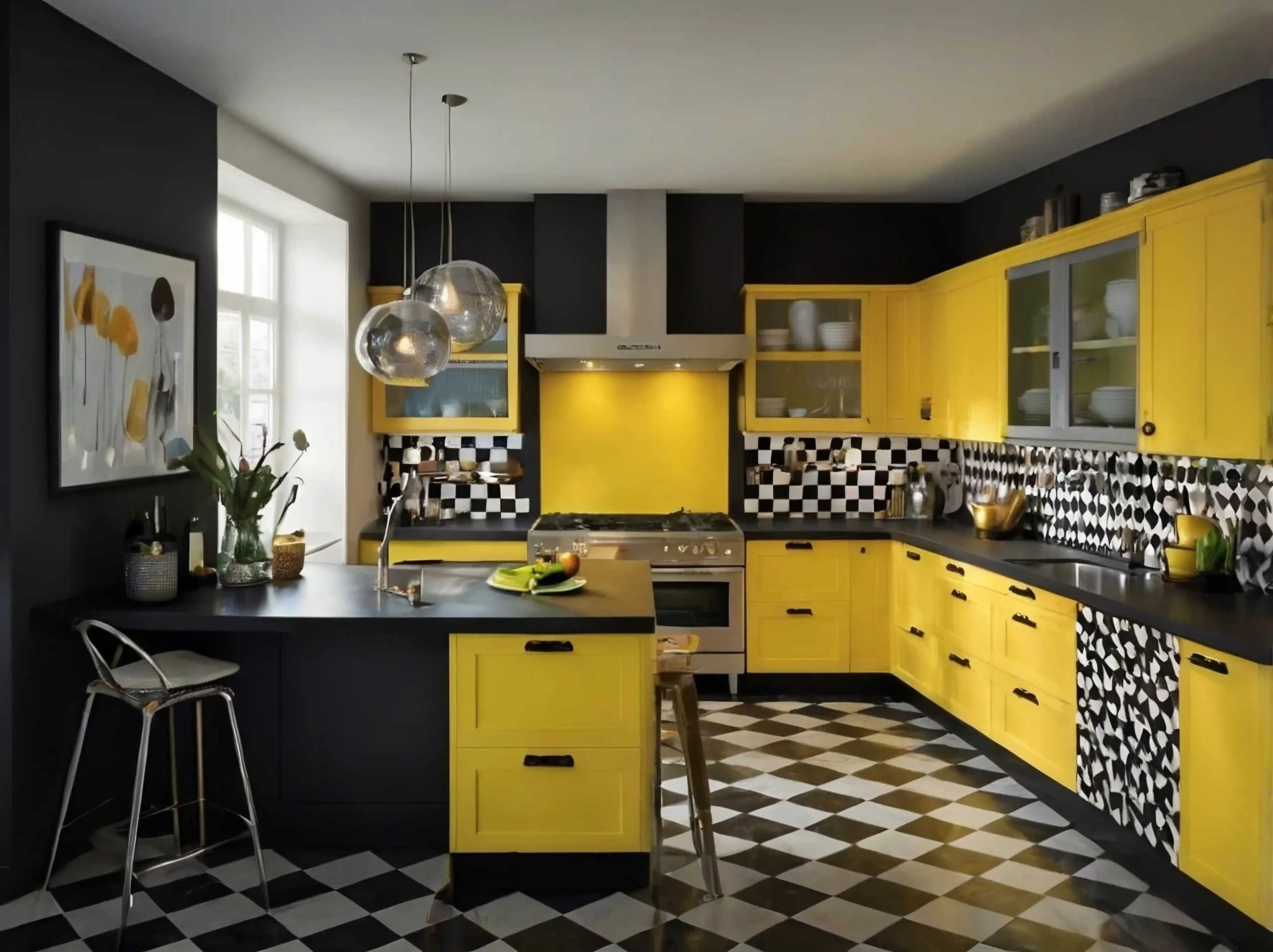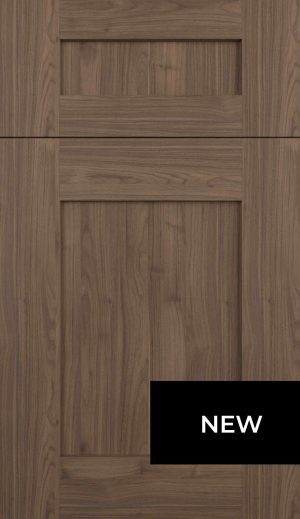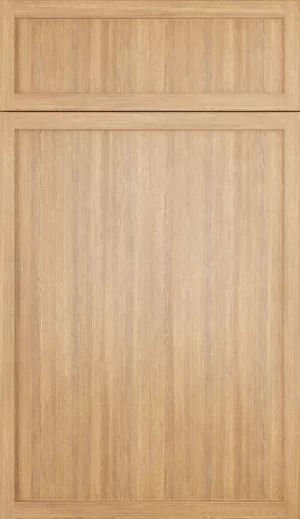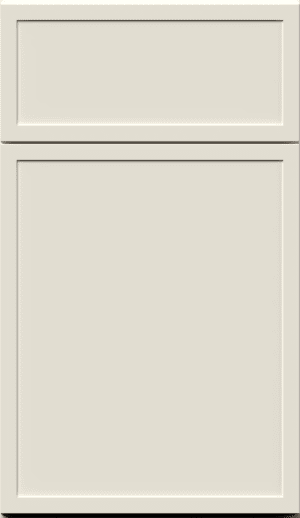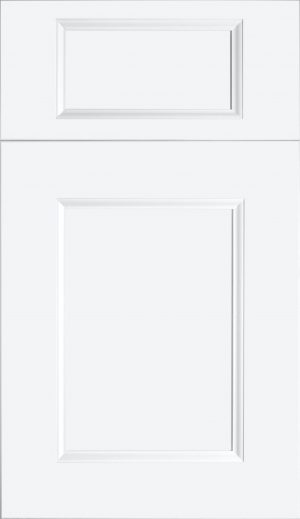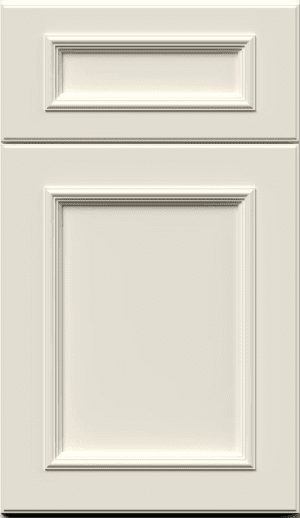You can’t forget about Shaker Style Cabinets vs. Recessed Panel Cabinets when choosing suitable cabinets for your kitchen. These two styles have distinct characteristics and can significantly impact the overall aesthetic of your kitchen.
Both are miles apart regarding cost, style, benefits, and drawbacks. This article will delve into each style’s essential features, helping you decide on your kitchen remodel or upgrade.
Understanding Shaker Style Cabinets
Before comparing Shaker vs. Recessed panel cabinets, we must learn about each cabinet’s history, advantages, and drawbacks.
Shaker cabinets are a popular and timeless style that originated in the 18th century from the Shaker religious community in America. Known for their simplicity, functionality, and clean lines, Shaker cabinets have remained famous for kitchen and bathroom designs.
A five-piece door with a flat recessed center panel and a simple frame characterizes the design of Shaker cabinets. Shaker design focuses on practicality, durability, and quality craftsmanship. The cabinets are typically made from solid wood, such as maple, cherry, or oak, which adds to their sturdiness and longevity.
Advantages of Shaker Style Cabinets
Now that you are aware of the Shaker style cabinet’s history let us take a look at each of the reasons these versatile cabinets are popular among homeowners:
- Classic and Timeless Design: Shaker cabinets feature a simple, clean, and timeless design that can complement various interior styles, from traditional to contemporary.
- Versatility: Shaker cabinets come in various sizes, finishes, and colors, allowing customization to match different design preferences and kitchen aesthetics.
- Durability: Shaker cabinets are typically constructed from high-quality materials such as solid wood, making them sturdy and long-lasting.
- Easy Maintenance: Shaker cabinets’ flat, smooth surfaces make them easy to clean and maintain. Regular dusting and occasional wiping with a mild detergent are usually sufficient to keep them looking great.
- Resale Value: Shaker cabinets have a broad appeal among homebuyers due to their classic design, which can increase the resale value of a home.
- Timeless Appeal: Shaker cabinets have been around for centuries and have stood the test, ensuring they won’t go out of style quickly.
- Design Flexibility: Shaker cabinets can be adapted to different design schemes and paired with various hardware options, countertop materials, and backsplashes, allowing for flexibility in creating a cohesive kitchen design.
Drawbacks of Shaker Cabinets:
While doing a shaker vs. recessed panel cabinets 2024 comparison, you will notice that Shaker has a lot of benefits. But, it also has some drawbacks we must consider:
- Cost: Shaker cabinets, particularly those made from solid wood, can be more expensive than other cabinet styles or materials.
- Limited Ornamentation: Shaker cabinets are known for their simplicity, so they may not appeal to those who prefer more ornate or decorative cabinet styles.
- Less Storage Space: Shaker cabinets’ flat, recessed panel design can result in slightly less storage space than those with raised panels.
- Prone to Fingerprints: Shaker cabinets with flat surfaces can show fingerprints and smudges more prominently, requiring frequent cleaning and maintenance.
- Limited Color Options: While Shaker cabinets offer a variety of finishes, they may not provide as extensive a range of color options as some other cabinet styles.
- Can Show Wear and Tear: Over time, the recessed panel design of Shaker cabinets can show signs of wear, particularly along the edges and corners.
- Lack of Decorative Detail: Shaker cabinets may not satisfy individuals who prefer intricate details or elaborate designs, as they focus on simplicity and functionality.
Exploring Recessed Panel Cabinets
You can’t decide between Shaker Style Cabinets vs. Recessed Panel Cabinets without knowing the history of both. Recessed cabinets, also known as flat-panel cabinets, are a popular style characterized by sleek and minimalist design. Unlike raised panel or Shaker cabinets, recessed cabinets have a flat surface without decorative elements or raised panels.
The defining feature of recessed cabinets is their smooth and streamlined appearance. The flat cabinet doors create a clean and modern aesthetic that works well in contemporary, modern, and transitional design schemes. Recessed cabinets offer a simple and uncluttered look, allowing other design elements in the room to take the spotlight.
Benefits of Recessed Panel Cabinets
The pros and cons of shaker and Flat cabinets are incomplete without diving into Flat cabinets’. The most popular choice for homeowners that want a minimalist appearance, it has many other benefits:
- Sleek and Streamlined Appearance: Recessed cabinets have a clean and minimalist look that can create a sleek and streamlined aesthetic in space.
- Versatile Design: Recessed cabinets can adapt to various design styles, from modern and contemporary to traditional and transitional, making them versatile for different kitchen or bathroom aesthetics.
- Ample Storage Space: Recessed cabinets often have larger storage capacity than other cabinet styles, thanks to their deeper design and absence of protruding frames or panels.
- Easy to Clean: Recessed cabinets’ smooth, flat surfaces make them easy to clean. There are no crevices or intricate details where dirt or grime can accumulate, simplifying the maintenance process.
- Customizable Options: Recessed cabinets can be customized with different materials, finishes, and hardware choices, allowing for personalization and integration with the overall design scheme.
- Durability: Recessed cabinets are typically constructed using high-quality materials, ensuring their durability and longevity, even with regular use.
- Timeless Appeal: Similar to Shaker cabinets, recessed cabinets have a timeless appeal that can withstand changing design trends, making them a long-lasting choice.
Drawbacks of Recessed Cabinets
Let us take a look at the drawbacks of recessed cabinets. While Shaker Style Cabinets vs. Recessed Panel Cabinets is a great cabinet choice, both have cons:
- Limited Ornamentation: Recessed cabinets have a simpler design without elaborate ornamentation, which may not appeal to individuals who prefer more decorative or ornate styles.
- Difficult to Clean Dust: The recessed design of these cabinets can make it challenging to remove dust from the corners or edges, requiring more thorough cleaning methods or specialized tools.
- Lack of Texture: Recessed cabinets can lack the texture and visual interest that raised panel or Shaker cabinets offer, which might disadvantage those seeking a more textured or dimensional look.
- Higher Cost: Depending on the materials and finishes chosen, recessed cabinets can be more expensive than other cabinet styles due to their larger size and potential for customization.
- Less Visual Depth: The flat surface of recessed cabinets can give a more uniform and flat appearance, which may not create as much visual depth or dimension in the overall design.
- Limited Hardware Options: The recessed design of these cabinets may limit the hardware options available for installation, as certain types of knobs or pulls may not be compatible or visually appealing with the clean lines of recessed cabinets.
- Less Trendy: While recessed cabinets have a timeless appeal, they may not be as trendy or fashion-forward as some cabinet styles incorporating more decorative elements or unique design features.
Shaker Style vs. Recessed Panel Cabinets: Style And Maintenance
When comparing Shaker style and recessed panel cabinets, it’s important to consider design aesthetics and visual impact. Shaker-style cabinets create a clean and uncluttered look, making them suitable for modern and transitional kitchens. On the other hand, recessed panel cabinets exude a sense of luxury and sophistication, making them a better fit for traditional or formal kitchen settings.
Additionally, Shaker vs. Recessed panel cabinet maintenance should be considered. Shaker-style cabinets, with their flat surfaces and simple lines, are generally easier to clean and maintain. Recessed panel cabinets, with their intricate detailing and additional crevices, may require more attention during cleaning to ensure all areas are adequately maintained.
Shaker Style vs. Recessed Panel Cabinets: Price Comparison
Shaker cabinets are a timeless and versatile kitchen and bathroom cabinetry choice. They are customizable with various finishes and hardware choices, allowing design flexibility. While Shaker cabinets can be more expensive than other styles, their classic appeal and a potential increase in resale value make them a worthwhile investment.
Recessed cabinets, also known as flat-panel cabinets, offer a sleek and minimalist design. They have a clean, streamlined appearance that works well in modern and contemporary spaces. Recessed cabinets provide ample storage space and are easy to clean due to their flat surfaces. Although they lack decorative detail, recessed cabinets are more affordable than Shaker cabinets, offering a cost-effective option for those seeking a clean and minimalist look.
Shaker cabinets generally fall into a higher price range when comparing prices due to their premium quality and solid wood construction. On the other hand, recessed cabinets are more moderately priced, offering a more affordable option without compromising style and functionality. The Shaker vs. Recessed panel cabinets cost can vary based on materials, finishes, customization options, and suppliers. Consulting local manufacturers or suppliers will provide more accurate pricing information based on specific preferences and requirements.
Shaker Style Vs. Recessed Panel Cabinets: Construction
To the untrained observer, shaker cabinets vs traditional recessed cabinets may appear indistinguishable—and in numerous instances, they are utilized interchangeably. Nevertheless, nuanced disparities do exist. Shaker cabinets feature a crisply defined, 90-degree recess within the panel. Conversely, recessed shaker cabinets often exhibit a slight slope or angled contour along the recess seam. This distinction arises from using the cope and stick construction technique in crafting Shaker doors, whereas alternative recessed panel styles employ mitered joints.
Shaker cabinets, due to their cope and stick assembly, exude a contemporary, clean-cut aesthetic. In contrast, mitered recessed panels emanate an exquisite, time-honored allure attributed to their intricate detailing and angled miter construction. Both mitered and cope and stick (Shaker) cabinet doors boast superior durability compared to flat panels, which are prone to distortion when exposed to elevated humidity.
Choosing the Right Cabinet Style for Your Kitchen
To choose the ideal Shaker vs. Recessed panel cabinet style for your kitchen, it’s essential to consider your personal design preferences and the overall style of your home. If you lean towards a more modern or minimalist aesthetic, Shaker-style cabinets might be the perfect fit. If you’re aiming for a more formal or traditional look, recessed panel cabinets can add a touch of elegance.
It’s also crucial to assess the functionality and practicality of each style. Consider your storage needs, kitchen layout, and how the cabinets complement other elements, such as countertops and backsplashes. Consulting with a professional designer or kitchen remodeler can provide valuable insights. IT will also help you make an informed decision that aligns with your budget constraints.
At A Glance
By now, you have learned everything there is to know about Shaker cabinets Vs. Recessed Panel cabinets. But our table will give you a look at all the important information at a glance:
| Factors | Shaker Style Cabinets | Recessed Panel Cabinets |
|---|---|---|
| Design | Classic and timeless with clean lines | Traditional with decorative recessed center panels |
| Aesthetic Appeal | Versatile and can complement various design styles | Elegant and ornate with a more traditional look |
| Construction | Five-piece door design with a flat center panel | Frame and panel construction with a recessed center panel |
| Durability | Sturdy construction using solid hardwoods | It can be customized with various finishes and hardware |
| Maintenance | Easy to clean and maintain | Easy to clean and maintain |
| Cost | Can range from moderate to high | Can range from moderate to high |
| Customization Options | Can be customized with various finishes and hardware | It can be customized with various finishes and hardware |
| Popularity | Widely used and popular in various design styles | Commonly used in traditional and formal designs |
| Overall Look | Timeless and elegant | Classic and more decorative |
Please note that the information provided is a general comparison, and the specific characteristics and attributes may vary depending on the manufacturer and individual cabinet options.
Conclusion
There is no absolute right or wrong choice in the debate of Shaker Style Cabinets vs. Recessed Panel Cabinets. It ultimately boils down to your taste, the style, and the desired ambiance you want. Shaker-style cabinets offer versatility, simplicity, and a timeless appeal. While recessed panel cabinets exude elegance and can elevate traditional kitchen designs. You can select the cabinet style that best reflects your vision by carefully considering your preferences and needs. You can head to our store, Badger Cabinets, in Oak Creek, Wisconsin, to find the cabinet that best fits your home.
Shaker-style cabinets, celebrated for their bold simplicity, bring a timeless charm to kitchens, while recessed panel cabinets offer a classic, understated elegance perfect for traditional and contemporary spaces alike. This guide explores their design differences, durability, and versatility to help you choose the ideal cabinet style for your unique kitchen vision.
FAQs
1. Which cabinet style is more popular?
Shaker-style cabinets are more popular in the current design landscape. Their timeless appeal and versatility have made them a go-to choice for many homeowners and designers. Shaker cabinets’ clean lines and classic aesthetic have allowed them to transcend design trends and remain popular for various kitchen styles.
2. Can Shaker-style cabinets be used in a modern kitchen?
Absolutely! Shaker-style cabinets can be used in a modern kitchen. Despite their traditional origins, Shaker cabinets have evolved to adapt to modern design aesthetics. Shaker-style cabinets can create a harmonious blend of classic charm and modern sophistication in a kitchen by selecting sleek finishes, incorporating contemporary hardware, and pairing them with modern elements.
3. Are recessed panel cabinets more expensive than Shaker style?
The cost of recessed panel vs shaker depends on various factors, such as materials, finishes, and customization options. Recessed panel cabinets may involve more intricate craftsmanship and decorative elements, which can increase the overall cost compared to Shaker-style cabinets.
4. How do I maintain and clean Shaker-style cabinets?
Maintaining and cleaning Shaker-style cabinets is relatively straightforward. Regular dusting and wiping down the surfaces with a soft cloth or microfiber cloth is typically sufficient. A mild soap or specialized cabinet cleaner can be used for deeper cleaning. It’s important to avoid abrasive cleaners or scrubbing tools that can damage the finish.
5. Can I mix and match cabinet styles in my kitchen remodel?
You can mix and match cabinet styles in your kitchen remodel. Mixing different cabinet styles can add visual interest and create a unique and personalized look. However, it’s important to ensure that the different styles complement each other and work cohesively within the overall design scheme. Consider factors such as the balance of proportions, coordinating finishes or colors, and the overall aesthetic you want to achieve.



